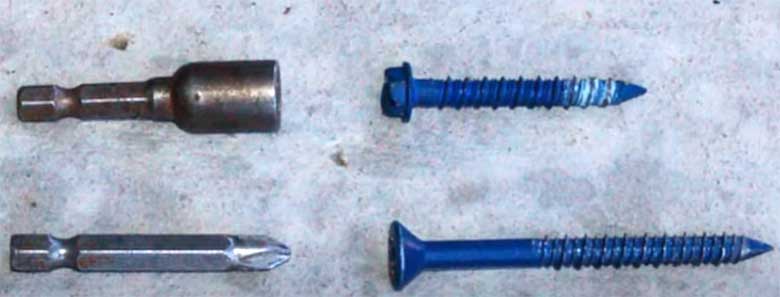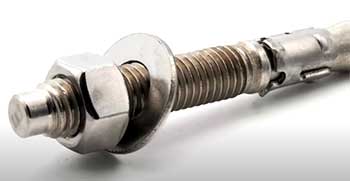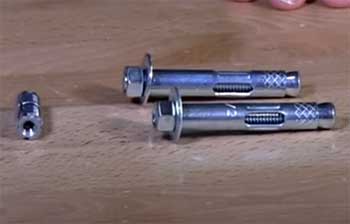If you want to attach an object to any concrete or masonry surface, the amount of work that needs to be done increases significantly from tasks that involve drywall or simple wood surfaces.
Thus, in order to complete these tasks, there are many different tools available in the market. One such tool is the concrete anchor.
While there are many concrete anchors available in the market, in this article, we will talk about wedge anchor and sleeve anchor, two very popular concrete anchors, and discuss their differences.
A Quick Comparison Table
But before we look into their key differences in detail, here is a chart that gives a quick overview of their differences:
| Criterion | Wedge Anchor | Sleeve Anchor |
| Strength | Higher | Lower |
| Versatility | Lower | Higher |
| Used In | Only Solid Concrete | Concrete, Brick, or Block |
| Holding Value | Higher | Lower |
In-depth Differences Between Wedge Anchor And Sleeve Anchor

Now that we have gotten a brief overview of their differences, let us look at their differences in detail. You might be thinking, both the wedge anchor and sleeve anchor look identical, and also serve the same purpose, so how are they different?
Well, the differences primarily come down to usage, conditions, and durability. Let us have a look.
- Application
There are many different types of anchors in the market, and they have different purposes.
While some anchors have been made to be extremely strong, others have been designed in a way to provide customers with greater versatility, and simplicity of usage.
Let us talk about the wedge anchor first. It is a very simple mechanical expansion that is made up of four different parts- an expansion clip, threaded anchor body, nut, and a washer.
Wedge anchors provide the most consistent and highest holding values of any mechanical expansion anchor available in the market. Wedge anchors give customers the best performance when they are installed on concrete.
The concrete is poured and heavy-duty applications such as wooden structures are anchored to the foundation.

On the contrary, sleeve anchors offer greater versatility and can be installed into brick, block, or concrete.
This versatility comes at the cost of weaker holding power in comparison to the wedge anchor which is more dedicated.
But on the brighter side, wedge anchors are lighter and have the advantage of being anchored to mortar, brick, and blocks. These are places where the use of wedge anchors is not recommended.
You can apply sleeve anchors to different projects. For example, you can use them to fix radiators in your home, as well as use them for much larger operations such as securing the joists of decking.
Just like wedge anchors, sleeve anchors serve through the expansion of their wedges, tightening the nut pulls, the stud end all the way into the expander sleeve, and then wedging it outwards.
After that, the anchor is locked into the base material, wedging the whole thing in place.
If your preference is a strong anchor, you will be pleased to know that wedge anchors are extremely popular because of their durability. Even though they look and function quite similarly to that of a sleeve anchor, they come with a much smaller sleeve near the base.
This is one of the prime reasons behind people choosing wedge anchors over sleeve anchors. Their durability and ability to withstand different conditions because of this higher durability make them very popular.
Learn more about wedge anchor from here!
- Construction
Wedge anchors are made of stainless steel. This construction makes them highly resistant to corrosion and durable. Also, they are highly usable for masonry applications.
You can even use underwater installations and dry settings for both indoors and outdoors. As we have mentioned before, their durability makes edge anchors adaptable to various altering environments.
On the contrary, sleeve anchors are very simple and mainly used in bricks or blocks. Even though they can be used in concrete, their lower durability means that it is recommended not to use them on concrete surfaces.
So people primarily use sleeve anchors for light or medium applications.
- Variety and Function

When it comes to types, sleeve anchors are primarily of two types: the Nut Drive, and the Slotted Combo Drive.
The Nut drive is usually used for extra strength, whilst the slotted combo drive is used when a flush surface is required.
The amount of weight a sleeve anchor can absorb solely depends on the material and size of the object it is being fastened to.
They generally fall into the medium-duty category. But is very important to be sure of the anchor’s specifications before you purchase because that will tell you how much weight it can carry.
So wedge anchors provide their users with the highest holding values, whilst sleeve anchors are far more versatile fasteners and these can be utilized in a variety of different places. This also includes concrete as the base material.
- Installation: Wedge Anchor
To set up a wedge anchor, you’ll want to drill a hollow this is equal in length because of the anchor and set it into the hollow. Once you’ve positioned the cloth being held to the concrete at the uncovered portion, placed the washing machine and thread the fastener onto the anchor.
As you tighten the nut in opposition to the washing machine, it’s going to, in turn, pull the anchor up. This will reason the wedge skirt to capture the concrete and expand, digging into the concrete because the anchor is pulled.
When putting in a wedge anchor, it’s advocated to have at least 2 ½ inches embedded into the concrete. There must additionally be no less than an inch uncovered, sufficient for the attaching substances to seize onto.
- Installation: Sleeve Anchor
To set up a sleeve anchor (the nut-pushed style), make a hollow and vicinity the sleeve anchor into the hollow. Then set the washing machine and nut onto the uncovered threading and begin fastening the nut.
As the anchor is driven up out of the concrete, the sleeve around it is going to begin to expand, wedging the anchor into the vicinity in the hollow.
The equal technique is relevant while putting in the Combo Flathead style; besides that, you’ll be the usage of a Phillips power and the setup will go away the pinnacle flush with the floor of the setup cloth.
In any case, the robust bond between the element and the concrete is more advantageous via way of means of friction. The key to ensuring you get a stable bond among the cloth and anchors is to drill a hollow of the proper diameter and depth.
If the hollow is simply too deep and wide, then there’s an honest danger the anchor will come free in time, which could result in extreme problems. Watch the installation video here!
- Minimum Length/Depth
The minimum length needed for sleeve anchors depends on the thickness of the material it is being fastened to.
With a wedge anchor, however, the rule of thumb is that the space for the nut and washer should equal the diameter of the wedge anchoring being employed.
- Versatility
Let’s judge both anchors based on their versatility. We always want more versatile things to keep, use and have in the house, work, or wherever required.
Here, the Sleeve anchors are more versatile and easier to use than wedge anchors. These sleeve anchors do not require more force and can be easily inserted into the desired places.
However, the versatility of Wedge anchors is less because they require more force to go into the desired surface or wall.
- Comfort In Usage
One can have these anchors for completing any jobs related to hanging pictures on the walls, fixing stuff, and more. But both anchors’ purpose is best to use them in the construction industry.
These anchors are solid and stand better in holding things against different surfaces or joining two different material items.
- Accessories
Most people say that Sleeve anchors and Wedge anchors are quite identical. It is true because they both come with the same specifications.
Here, with a wedge anchor, you will find a flat washer and finished hex that suits best to use in more hollow surfaces.
On the other hand, the Wedge anchor comes with a flash washer and hex nut that is desired to use at places where you are looking for a stronger grip.
Both are made of stainless steel material and used for the same purposes.
- Removal of an Anchor
Sometimes you have to remove the old anchors and install the new ones or fix the walls. In that case, it would become a little hard for you to remove the Wedge anchor because of its different construction and form factor.
But with the Sleeve Anchor, you can remove it without facing any problems. Just pick it from the head, and it will be removed from the surface with a gentle force.
This helps you decide which is comfortable for your specific job.
- Usage for
Some constructors also recommend that a sleeve anchor is better for a shorter period, whereas the Wedge anchor is best for a longer period.
Hence, you can decide how long you want a thing to be hanged against the wall or fixed against it!
Frequently Asked Questions (FAQs)
A concrete wedge anchor is considered to be a male anchor. This is because male anchors are used to fasten to the concrete base by using both a nut and a washer.
Wedge Anchors can be removed from concrete in one of two ways:
1. If the hole beneath the anchor is deep enough, simply pound it into the concrete with a hammer.
2. Use a saw or grinding wheel to cut the anchor off right above the surface and pound the rest flat with a hammer.
Wedge Anchor diameter is measured from the outside of the threads. Wedge Anchor length is measured as the entire length of the bolt. Drill a hole in the concrete at least 1/2″ deeper than the desired embedment depth. Thread the nut with the washer just onto the end of the bolt.
Sleeve anchors can be used in concrete, block, or brick. But given that their holding value is less than that of wedge anchors, it is not recommended to do so.
When you compare the wedge anchors from different manufacturers, it is important to keep in mind that they are all the same items with different features.
Sleeve anchors are versatile. As a result, you can apply them to many different kinds of projects. You can also use them on a variety of different materials due to their versatility.
Final Words….
Whether you want to buy a wedge anchor or a sleeve anchor depends entirely on the conditions that you are in. We recommend doing proper research on your surrounding elements before deciding which anchor is the right fit for you.
If needed, you should hire a professional to do the job as your inexperience might end up costing you way more than you expected. We hope wedge anchor and sleeve anchor will be of help to you.
Best wishes!
